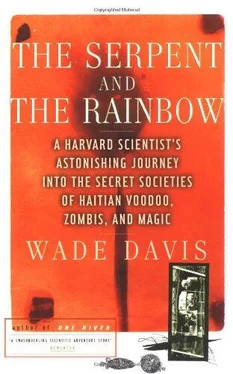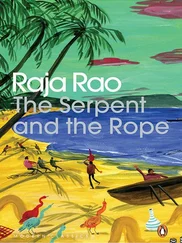Wade Davis - The Serpent and the Rainbow
Здесь есть возможность читать онлайн «Wade Davis - The Serpent and the Rainbow» весь текст электронной книги совершенно бесплатно (целиком полную версию без сокращений). В некоторых случаях можно слушать аудио, скачать через торрент в формате fb2 и присутствует краткое содержание. Год выпуска: 1985, Издательство: Simon & Schuster, Жанр: Старинная литература, на английском языке. Описание произведения, (предисловие) а так же отзывы посетителей доступны на портале библиотеки ЛибКат.
- Название:The Serpent and the Rainbow
- Автор:
- Издательство:Simon & Schuster
- Жанр:
- Год:1985
- ISBN:нет данных
- Рейтинг книги:5 / 5. Голосов: 1
-
Избранное:Добавить в избранное
- Отзывы:
-
Ваша оценка:
- 100
- 1
- 2
- 3
- 4
- 5
The Serpent and the Rainbow: краткое содержание, описание и аннотация
Предлагаем к чтению аннотацию, описание, краткое содержание или предисловие (зависит от того, что написал сам автор книги «The Serpent and the Rainbow»). Если вы не нашли необходимую информацию о книге — напишите в комментариях, мы постараемся отыскать её.
The Serpent and the Rainbow — читать онлайн бесплатно полную книгу (весь текст) целиком
Ниже представлен текст книги, разбитый по страницам. Система сохранения места последней прочитанной страницы, позволяет с удобством читать онлайн бесплатно книгу «The Serpent and the Rainbow», без необходимости каждый раз заново искать на чём Вы остановились. Поставьте закладку, и сможете в любой момент перейти на страницу, на которой закончили чтение.
Интервал:
Закладка:
9. IN SUMMER THE PILGRIMS WALK
The biogenesis of tetrodotoxin is discussed in Halstead, B. W. (1978). The use of Duboisia myoporoides as an antidote to ciguatera poisoning is documented in Dufra, E., G. Loison, B. Holmstedt, Duboisia myoporoides: native antidote against ciguatera poisoning, Toxic on 14 (1976): 55-64.
10. THE SERPENT AND THE RAINBOW
An account of the apparition of the Virgin Mary is given in Herskovits, M.J. (1937).
For ethnological information on possession see: Bourguignon, E., Possession , Chandler & Sharp Publishers, Inc., San Francisco, 1976; Zuesse, E. V., Ritual Cosmos—The Sanctification of Life in African Religions , Ohio University Press, Athens, OH, 1980. For traditional medical studies see: Dorsainvil, J. C, Vodou et névroses , Imprimerie La Presse, Port-au-Prince, 1931; Mars, L. The Crisis of Possession in Voodoo , Reed, Cannon & Johnson Co., Berkeley, 1977; Price-Mars, J. (1983). For descriptions of possession in the context of contemporary ritual see: Deren, M. (1953), and Lowenthal, I., Ritual performance and religious experience: a service for the gods in southern Haiti, Journal of Anthropological Research 34, no. 3 (1978): 392-415; Laguerre, M. S. The festival of gods: spirit possession in Haitian voodoo, Freeing the Spirit 5, no. 2 (1977): 23-35.
For discussions of the nature of the vodoun soul see: Métraux, A., The concept of soul in Haitian Vodu, Southwestern Journal of Anthropology 2 (1946): 84-92; and Deren, M. (1953). My findings are at odds with both these sources in certain ways, but the most important difference is actually one of semantics. What I refer to as the “ti bon ange” for example, other investigators have called the “gros bon ange”; the actual functions of the two aspects of the vodoun soul are consistent. Métraux himself suggested that research into the nature of the vodoun soul is made “difficult by the wide range of beliefs and theories found among Haitian Vodu worshippers according to their intellectual sophistication, their religious background and contacts with the modern world” (Métraux, 1946, p. 84). Métraux based his interpretation largely on interviews of a single informant at the Bureau of Ethnology in Port-au-Prince. He notes that many of her statements were contradicted outright by the one houngan he also interviewed. Métraux based his conclusions on his “impression that [his informant’s] candid statements reflected more closely the general beliefs of the Haitian peasantry” (Métraux, 1946, p. 85). When I commented on the range of professional interpretations by anthropologists to one of my informants I was impressed by his response. He suggested that the diverse opinions reflected the anthropologists’ implicit assumption that every vodoun initiate or even every houngan necessarily had the answers to all complex theological questions. Would one expect, he asked, that every French peasant or parish priest would be able to or even be interested in addressing theological issues normally considered by the Vatican alone?
For papers on vodoun ethnomedicine see: Métraux, A., Médecine et Vodou en Haiti, Acta Tropica 10, no. 1 (1953): 28-68; Delbeau, J. C, “La Médicine Populaire en Haiti,” doctoral dissertation, Université de Bordeaux, 1969; Denis, L., Médecine populaire, Bulletin du Bureau d’Ethnologie d’Haiti 4, no. 29 (1963): 37-39.
Notes on Haitian ethnobotany are provided in: Brutus, et al. (1960); Leon, R., Phytothérapie Haïtienne, nos simples . Imprimerie de l’Etat, Port-au-Prince, 1959; Les P. Missionaires du T. S. Rédempteur, Haiti flore Médicinale , Monastère Saint Gerard, Port-au-Prince, 1943.
A comparison between Western scientific thinking and traditional ways of thought in Africa is discussed in Horton, R., African traditional thought and western science, Africa 37, no. 1 (1967): 50-71, 155-87. The entire concept of balance and equilibrium as a key to health in our society is given an excellent treatment by Weil, A. T. (1983).
11. TELL MY HORSE
In addition to the historical sources already noted, marronnage is discussed in: Debbash, Y., Le Marronnage: Essai sur la désertion de l’esclave Antillais, L’Année Sociologique 3 (1961): 1-112, 117-95; Débien, G., Le Marronnage aux Antilles Françaises au XVIII esiècle, Caribbean Studies 6, no. 3 (1966): 3-44; Manigat, L. F., The relationship between Marronnage and slave revolts and revolution in St. Domingue-Haiti, in Rubin, V., and A. Tuden, eds., Comparative Perspectives on Slavery in New World Plantation Societies , The New York Academy of Sciences, New York, 1977; Price, R., ed., Maroon Societies: Rebel Slave Communities in the Americas , The Johns Hopkins University Press, Baltimore, 1979. The single most valuable source for my work was Fouchard, J. (1981).
There is an extensive literature on secret societies. Among the general sources are: MacKenzie, N., Secret Societies , Collier Books, New York, 1967; Mak, L. F., The Sociology of Secret Societies , Oxford University Press, Kuala Lumpur, 1981; Webster, H., Primitive Secret Societies , Octagon Books, New York, 1968. A theoretical discussion of the nature of secret societies is presented in Wolff, K., ed., The Sociology of Georg Simmel , The Free Press, Glencoe, IL, 1950.
Among the valuable references on the secret societies of West Africa are:
Agiri, B. The Ogboni among the Oyo-Yoruba. Lagos Notes and Records 3, no. II (1972): 50-59.
Bascom, W. “Secret Societies, Religious Cult Groups and Kinship Units Among the West African Yoruba.” Ph.D. dissertation, Northwestern University, Evanston, IL, 1939.
Bellman, B. Village of Curers and Assassins . Mouton, Paris, 1975.
Butt-Thompson, F. W. West African Secret Societies . H. F. & G. Witherby, London, 1929.
Harley, G. W. Notes on the Poro in Liberia . Peabody Museum Papers 19, no. 2, Harvard University, Cambridge, 1944.
Harris, W. T., and H. Sawyer. The Springs of Mende Belief and Conduct . Sierra Leone University Press, Freetown, 1968.
Herskovits, M. J. Dahomey . 2 vols. J. J. Augustin, New York, 1938.
Jedrej, M. C. Structural aspects of a West African secret society. Journal of Anthropological Research 32, no. 3 (1976): 234-45.
_______. Medicine, fetish and secret society in a West African culture. Africa 46, no. 3 (1976): 247-57.
Little, K. The Poro as an arbiter of culture. African Studies 7, no. 1 (1948):
_______. The role of the secret society in cultural specialisation. American Anthropologist 51 (1949): 199-212.
_______. The Mende of Sierra Leone . London, 1951.
_______. Political function of the Poro, pt. 1. Africa 35, no. 4 (1965), 349-65.
_______. Political function of the Poro, pt. 2. Africa 36, no. 1 (1966): 62-71.
Magid, A. Political traditionalism in Nigeria: a case study of secret societies and dance groups in local government. Africa 42, no. 4 (1972), 289-304.
Morton-Williams, P. The Yoruba Ogboni cult in Oyo. Africa 30, no. 4 (1980): 362-74.
Murphy, W. Secret knowledge as property and power in Kpelle society: elders vs. youth. Africa 50 (1980): 193-207.
Ortenberg, S. Leadership and Authority in an African Society . University of Washington Press, 1971.
_______, ed. African Religious Groups and Beliefs . Archana Publications, 1982.
Weckman, G. Primitive secret societies as religious organizations. International Review for the History of Religions 17 (1970): 83-94.
Читать дальшеИнтервал:
Закладка:
Похожие книги на «The Serpent and the Rainbow»
Представляем Вашему вниманию похожие книги на «The Serpent and the Rainbow» списком для выбора. Мы отобрали схожую по названию и смыслу литературу в надежде предоставить читателям больше вариантов отыскать новые, интересные, ещё непрочитанные произведения.
Обсуждение, отзывы о книге «The Serpent and the Rainbow» и просто собственные мнения читателей. Оставьте ваши комментарии, напишите, что Вы думаете о произведении, его смысле или главных героях. Укажите что конкретно понравилось, а что нет, и почему Вы так считаете.












